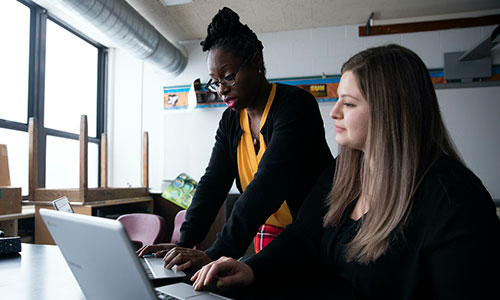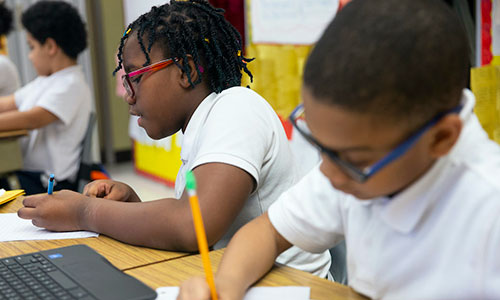Writing quality individual education plans (IEPs) that give a clear view of a student’s strengths and needs is such an important part of a special education teacher’s job. For all other teachers, IEP best practices can help ensure all students get the support they need.
I spent the first 13 years of my K–2 teaching career performing academic testing for eligibility for special education services and then writing eligibility determination paperwork and IEPs for my students. It has been more than a decade since I wrote a plan (I left the workforce for a few years after the birth of my third child), but once a teacher, always a teacher. Since leaving the classroom, I have volunteered as an advocate for families as they navigate the evaluation and IEP process in their school.
A lot has changed in the last decade. Many states now require dyslexia screening of young students, for example, which leads to earlier identification and earlier access to services. But one thing has stayed the same: a well-written IEP that is read and understood by all members of a learning team is imperative to student success.
Spring is IEP season. It is the best time to review IEP goals and amend plans for transitions from one grade to the next. Here are some things to consider.
Step 1: Define the learning team
As you prepare for annual IEP review meetings, it is important for each member of the learning team to be present to ensure their communication with students and families is clear and that they check frequently for understanding. Each member of a learning team is important and needs to understand both their role and the information in the IEP.
Student
The student is the most important member of any learning team! Student participation throughout the process, including in meetings, will ensure they have a voice in their education. I have had children as young as nine attend their IEP meetings, and although it is not necessary that early on, if a student is interested, be sure to include them. As a student gets older, they should have increased responsibility in the meetings. Be sure to ask them questions and give them plenty of time to speak, too; they will have the most valuable, up-to-date information regarding what they need to meet their goals, especially as they travel from class to class and teacher to teacher.
Family
A student’s at-home support system is invaluable. Be mindful of relationships because not all parents live in the same household and some kids may be cared for by a grandparent, adult sibling, or other guardian. Be sure to include everyone and be prepared to make duplicate copies of correspondence so family can stay informed. Be proactive and find out if a translator is needed (request them ahead of time if there’s a need). Sometimes, parents have family or others they trust for translating and they should be invited as well. But ensure the school also provides a translator who is well versed in the type of information being presented so the family does not miss anything important. Finally, someone on the school team should take the role of advocating for families to ensure they understand everything that is being discussed.
Teachers
While a student’s classroom teacher and special education teacher are usually the only ones at an IEP meeting, all teachers who work with a student should be familiar with the IEP. Teachers who teach classes covered by goal areas and teachers who teach classes that may be covered in accommodations only should have access to the IEP, read it thoroughly, and ask questions if anything is unclear. The IEP manager should ensure all teachers who have a role in implementing IEP goals or accommodations are clear on what they need to do to support the student.
Specialists
Speech language pathologists, occupational therapists, school psychologists, social workers, physical therapists, school nurses, work transition specialists, guidance counselors, education specialists, and any other education professionals who work with a student or are in charge of coordinating paperwork must be a part of the learning team. It is really important that any professional who is communicating information about a student presents that information in a positive, factual manner. Be mindful of any jargon and make sure that students, their families, and other teachers understand what is being said. It can be tempting to hide behind jargon when presenting delicate information. Be mindful of this and ensure the family understands the information being presented.
Step 2: Present levels of academic achievement, functional performance, strengths, and needs
When discussing the IEP, it is important to accentuate the positive but not minimize the areas of need. Keep the focus on the goals and the plan that is in place to ensure the student can achieve them. The staff member acting as an advocate for the family may need to pre-meet with them to go over anything that may contain difficult-to-understand or potentially upsetting information. Again, avoid relying on educational jargon only in this space, as noneducators may not understand fully and may be afraid to ask.
The strengths and needs portion of the IEP will have come from the eligibility conference and doesn’t change until the reevaluation. The needs are used to drive the goals (which, in turn, drive services), and the strengths are used to determine the areas to highlight when teaching, writing accommodations, and motivating the student.
“Present levels of academic achievement and functional performance” (formerly known as “Present levels of performance”) indicate where the student is currently performing in each developmental area. This portion of the IEP serves as a narrative, but it also contains qualitative or quantitative information about the student’s achievement and performance. The focus here is on where the student is currently compared to how far the student may need to go and what, if anything, needs to happen to bridge the gap.
Educators or family members should have a clear grasp of what the student can do by reading this portion of the IEP. It sets the stage for the goals that are written for any need-based area. It is also a great place to highlight strengths a student has, both in need-based areas and in areas where there will be no goal written.
Step 3: Set goals
As you begin working on IEPs for next year, please don’t ignore the existing IEP or carry over the same goals and present levels. Be honest with yourself and the rest of the learning team as you look at the existing IEP and write a comprehensive update. Rely on your student’s strengths and areas of growth and really capitalize on those in the goal-setting process.
As I mentioned earlier, goals are written to address each area of need identified during a student’s eligibility conference. If there are four areas of need identified, then there should be (at least) four goals written to cover the areas of need. The goals should be:
- Succinct. Aim for one to two sentences.
- SMART. “SMART” stands for specific, measurable, attainable, relevant, and timely.
- Ambitious. Keep the bar high for each and every student. The point of an IEP is to help a student close a gap, so goals should be written to allow them to achieve more in the school year than the average student. This is how we close the gap.
Student and family input for this portion is imperative. Involve them in meetings and discussions prior to writing the goals.
Step 4: Understand “accommodations” and “modifications,” and decide how to use them
Some people say the “Present levels of academic achievement and functional performance” is their favorite section of the IEP. I think mine is the accommodations section.
The International Dyslexia Association has a great definition for “accommodation” that makes it easier to differentiate between an accommodation and a modification. They say, “Accommodations are adjustments made to allow a student to demonstrate knowledge, skills, and abilities without lowering learning or performance expectations and without changing what is being measured (e.g., providing text in audio-format when academic knowledge [e.g., history, biology, literature] is the target skill being measured).” They go on to explain that giving a student a needed accommodation to help them access curriculum or show what they learned is not giving them an “unfair advantage” or changing the scope of what they have to do; it is leveling the playing field for the student with a disability. To further drive this point home, I love this popular visual published on diffen.com. It shows just how important this part of the IEP really is.
Modifications are different in that they are changes to work expectations (e.g., only doing the even numbers in an assignment instead of all of them) or changes to content. I believe modifications can be really beneficial when setting work expectations, but they should be used sparingly because most content modifications lower grade-level expectations. This does not allow a student to access grade-level curriculum, which does not help them close the gap in their learning.
Choosing accommodations or modifications for a student should be purposeful and thought-driven. As a student ages and becomes more involved in their education, they should be an active participant in this portion of the process as well. Keep the strengths and needs along with the goals handy as this portion of the IEP is completed.
Ensure IEP success
An IEP is a legal document written to ensure success, as well as an equitable learning experience. It needs to be reflective of the student’s strengths and need areas, with goals that set high expectations and allow for appropriate accommodations and modifications.









